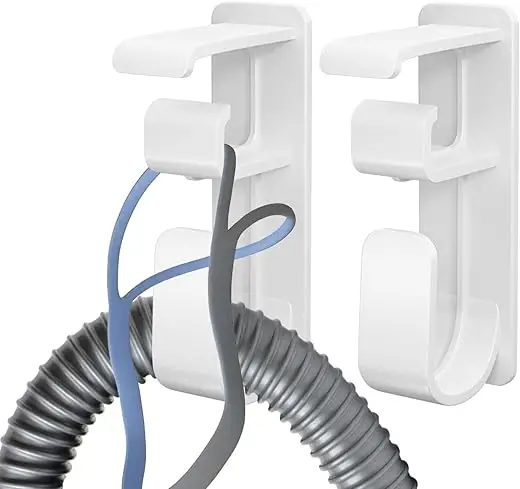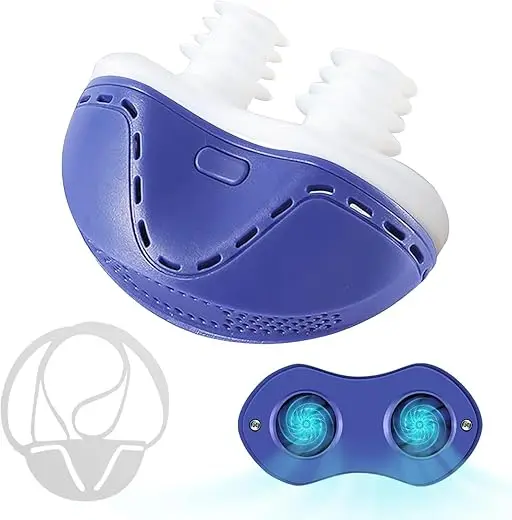The Toddler Sleep Crisis No One Talks About
Sleep apnea affects 2-3% of toddlers, with rates reaching 10-20% in those with enlarged tonsils or adenoids. Unlike adults who become sleepy, toddlers with sleep apnea often become hyperactive, aggressive, and are frequently misdiagnosed with ADHD or behavioral disorders. Left untreated, toddler sleep apnea can cause permanent developmental delays, growth problems, and cognitive impairment.
Your energetic two-year-old who snores “cutely” and sleeps in weird positions might not just be a restless sleeper. They could be fighting for oxygen all night long. This comprehensive guide helps parents recognize the often-missed signs of sleep apnea in toddlers, understand why it’s different from adult sleep apnea, and know exactly when to seek help.
Why Toddlers Are Uniquely Vulnerable
The Anatomical Reality
Toddler Airways Are Tiny:
- Airway diameter: only 4-6mm (adult: 15-20mm)
- 1mm swelling = 50% obstruction
- Tonsils/adenoids proportionally huge
- Tongue large for mouth size
- Facial structure still developing
Peak Problem Age:
- Lymphoid tissue peaks at age 2-6
- Tonsils/adenoids largest relative to airway
- Before facial growth compensates
- Critical brain development period
- Foundation years for learning
Developmental Impact
Why Timing Matters: Ages 1-3 are critical for:
- Language explosion (50 to 1,000+ words)
- Social skill development
- Emotional regulation learning
- Motor skill refinement
- Brain growing to 80% adult size
Sleep apnea during these years doesn’t just affect sleep—it can permanently alter development.
Classic Toddler Sleep Apnea Symptoms
Nighttime Red Flags
Breathing Disruptions:
- Snoring (even “quiet” snoring abnormal)
- Pauses in breathing >10 seconds
- Gasping or choking sounds
- Mouth breathing constantly
- Noisy breathing even without snoring
- Snorting or coughing during sleep
Sleep Position Clues:
- Sleeping with neck hyperextended
- Head hanging off bed/pillow
- Sleeping sitting up
- Constant position changes
- Prefers sleeping on parent’s chest
- Can only sleep in car seat/swing
Physical Signs During Sleep:
- Sweating excessively (especially head)
- Restless, thrashing sleep
- Frequent awakening (more than age-appropriate)
- Bedwetting after being dry
- Night terrors or confused awakening
- Sleep talking/walking
Daytime Symptoms Most Parents Miss
The Hyperactivity Paradox: Unlike adults who get sleepy, toddlers with sleep apnea often show:
- Extreme hyperactivity
- Inability to sit still
- Constant motion
- Aggressive behavior
- Impulsivity beyond typical toddler level
- “Wound up” appearance
Behavioral Red Flags:
- Tantrums beyond terrible twos
- Emotional meltdowns
- Difficulty with transitions
- Aggression toward siblings/pets
- Defiance exceeding age norms
- Inability to self-soothe
Developmental Concerns:
- Speech delays or regression
- Not meeting milestones
- Poor attention span for age
- Difficulty with potty training
- Social skill problems
- Learning delays apparent
Age-Specific Presentations
12-18 Months
Unique to This Age:
- Snoring dismissed as “baby sounds”
- Frequent “teething” wakings (actually apnea)
- Refuses to sleep flat
- Chronic congestion
- Poor weight gain
- Delayed walking/talking
Parent Observations: “Always seemed congested” “Never slept through night” “Constantly sick” “Behind other babies”
18-24 Months
Emerging Problems:
- Language explosion doesn’t happen
- Two-word phrases delayed
- Extreme terrible twos
- Picky eating (tired, throat sore)
- Growth curve flattening
- Needs multiple naps
Misdiagnoses Common:
- Speech delay
- Autism spectrum
- Sensory processing disorder
- Just “spirited” child
2-3 Years
Peak Problem Period:
- Tonsils/adenoids largest
- Behavior problems escalate
- Preschool complaints begin
- Social problems emerge
- Cognitive gaps apparent
- Physical symptoms obvious
School Readiness Impact:
- Can’t sit for circle time
- Won’t nap at school
- Aggressive with peers
- Can’t follow instructions
- Behind in pre-academic skills
Physical Signs Parents Can See
Facial Features
“Adenoid Face” Development:
- Mouth constantly open
- Long, narrow face
- Dark circles under eyes (“allergic shiners”)
- Dental problems (overbite, crowding)
- Receding chin
- Flattened cheekbones
Why It Happens: Chronic mouth breathing changes facial development permanently if not corrected early.
Growth Problems
Growth Hormone Disruption:
- Height below growth curve
- Weight gain poor or excessive
- Head circumference normal (brain prioritized)
- Delayed bone age on X-ray
- Muscle tone poor
The Science: Growth hormone releases during deep sleep. Sleep apnea prevents deep sleep, stunting growth.
Observable Signs
What Parents Notice:
- Always has mouth open
- Drools excessively
- Chronic runny nose
- Frequent ear infections
- Bad breath despite brushing
- Difficulty swallowing
The Behavioral Mimics
Often Misdiagnosed As ADHD
Overlapping Symptoms:
- Hyperactivity
- Inattention
- Impulsivity
- Difficulty sitting still
- Not listening
- Constant motion
Key Difference: ADHD is consistent; sleep apnea symptoms worse in afternoon/evening and improve with naps.
Mistaken for Autism Spectrum
Similar Presentations:
- Social difficulties
- Communication delays
- Sensory issues
- Rigid behaviors
- Meltdowns
- Developmental delays
Distinguishing Factor: Sleep apnea causes secondary symptoms that improve with treatment; autism is neurological difference.
Confused with Oppositional Defiant Disorder
Behavioral Overlap:
- Defiance
- Aggression
- Tantrums
- Rule-breaking
- Arguing
- Revenge-seeking
Critical Clue: Check sleep first before behavioral diagnosis—exhausted toddlers can’t regulate emotions.
When to Worry: Severity Indicators
Mild Sleep Apnea Signs
- Snoring 3+ nights/week
- Occasional gasping
- Restless sleep
- Some behavior issues
- Mild developmental concerns
Moderate Warning Signs
- Nightly snoring
- Witnessed pauses
- Frequent awakening
- Significant behavior problems
- Clear developmental delays
Severe Emergency Signs
- Breathing pauses >20 seconds
- Color changes (blue/gray)
- Failure to thrive
- Extreme behavior
- Multiple developmental delays
The Consequences of Untreated Toddler Sleep Apnea
Immediate Effects
Daily Life Impact:
- Constant meltdowns
- Unsafe behavior
- Preschool problems
- Family stress
- Parental exhaustion
- Sibling resentment
Short-term (6-12 months)
Developmental Costs:
- Language delays compound
- Social skills don’t develop
- Pre-academic skills lag
- Growth falls behind
- Behavior escalates
- Medical problems increase
Long-term Damage
Permanent Changes:
- Facial structure altered
- Cognitive potential reduced
- ADHD-like symptoms persist
- Learning disabilities
- Social difficulties
- Cardiovascular changes
Studies Show:
- IQ 10-15 points lower
- Reading problems 3x higher
- ADHD diagnosis 40% higher
- School failure increased
- Adult sleep apnea likely
Getting Your Toddler Diagnosed
Overcoming Dismissal
Common Doctor Responses:
- “Toddlers snore”
- “They’ll grow out of it”
- “Just allergies”
- “Behavioral phase”
- “Wait and see”
Your Response: “My child has [specific symptoms]. I’m concerned about sleep apnea and request evaluation by pediatric ENT or sleep specialist.”
Documenting Evidence
What to Track:
- Video breathing at night
- Audio record snoring
- Sleep diary 2 weeks
- Behavior patterns
- Growth charts
- Development concerns
The Diagnostic Process
Pediatric Sleep Study:
- Different from adult study
- Parent stays overnight
- Child-friendly environment
- Extra monitoring for safety
- Specialized scoring criteria
Alternative Assessments:
- Overnight oximetry
- Nap study sometimes sufficient
- ENT evaluation
- Lateral neck X-ray
- Sleep questionnaires
Treatment Options for Toddlers
First-Line: Adenotonsillectomy
Success Statistics:
- 80-90% cure rate
- Immediate improvement
- Behavior normalizes quickly
- Growth catch-up rapid
- Development accelerates
Surgery Specifics:
- Outpatient usually
- Recovery 7-10 days
- Pain manageable
- Risk low with experienced surgeon
- Life-changing results
When Surgery Isn’t Enough
Additional Treatments:
- CPAP (challenging but possible)
- Orthodontic expansion
- Allergy management
- Weight management if needed
- Myofunctional therapy
CPAP for Toddlers
Making It Work:
- Desensitization program essential
- Special pediatric masks
- Lower pressures needed
- Parent involvement crucial
- Behavioral rewards
- Gradual introduction
Success Tips:
- Make it fun (decorate mask)
- Practice during day
- Watch shows together
- Positive reinforcement
- Never force
- Consistency key
Home Management Strategies
Immediate Helps
Tonight’s Changes:
- Elevate head of bed
- Remove allergens
- Cool mist humidifier
- Side sleeping position
- Clear nasal passages
- Remove stuffed animals
Environmental Modifications
Bedroom Optimization:
- HEPA filter
- Dust mite covers
- No pets in room
- Fragrance-free
- Cool temperature
- Dark environment
Daily Routines
Supporting Better Sleep:
- Consistent bedtime
- No screens 2 hours before
- Calm bedtime routine
- Avoid overtiredness
- Strategic napping
- Early dinner
Living with a Toddler with Sleep Apnea
Family Impact
Parental Stress:
- Exhaustion from night wakings
- Behavioral management fatigue
- Worry about development
- Relationship strain
- Work impacts
- Guilt feelings
Sibling Effects:
- Less attention
- Disrupted sleep
- Behavioral modeling
- Resentment possible
- Anxiety about sibling
Coping Strategies
For Parents:
- Take shifts at night
- Seek respite care
- Join support groups
- Therapy for stress
- Maintain boundaries
- Self-care essential
For Family:
- Family therapy
- Sibling special time
- Extended family help
- Routine crucial
- Celebrate improvements
- Stay unified
Success Stories
Emma, Age 2.5
“Diagnosed with ADHD at 2. Finally got sleep study—severe OSA from huge tonsils. Two weeks post-surgery: different child. Speaking in sentences, tantrums gone, growing again.”
Marcus, Age 3
“Couldn’t handle preschool, aggressive, speech delayed. Adenotonsillectomy changed everything. Six months later testing above average. Teacher amazed.”
Lily, Age 2
“Failure to thrive, developmental delays, autism suspected. Turned out to be sleep apnea. Treatment = normal development resumed. Early intervention saved her future.”
When to Take Action
Tonight If:
- Breathing pauses witnessed
- Color changes ever
- Extreme behavioral crisis
- Growth stopped
- Multiple red flags
This Week If:
- Snoring regularly
- Behavioral problems escalating
- Development concerns
- Sleep severely disrupted
- Family struggling
Monitor If:
- Occasional snoring
- Mild restlessness
- Some behavioral issues
- Meeting milestones
- Growing normally
Your Action Plan
Immediate Steps
- Video tonight’s sleep
- Document symptoms
- Track behavior patterns
- Schedule pediatrician
- Request specialist referral
This Week
- Sleep diary start
- Growth chart review
- Development checklist
- Research specialists
- Insurance verification
Moving Forward
- Push for evaluation
- Don’t accept dismissal
- Get proper testing
- Pursue treatment
- Monitor progress
The Bottom Line: Time Is Brain
Every night your toddler struggles to breathe is a night of lost development. The toddler years are critical for brain growth, language development, and social learning. Sleep apnea during this period doesn’t just affect sleep—it steals potential.
The good news: toddler sleep apnea is highly treatable with excellent outcomes. Most children experience dramatic improvement within weeks of treatment. Behavior normalizes, development accelerates, and families heal.
Don’t wait. Don’t accept “they’ll grow out of it.” If your toddler shows these symptoms, fight for evaluation and treatment. Your child’s future cognitive ability, emotional health, and physical development depend on healthy sleep now.
Trust your instincts. You know when something’s wrong with your child. If sleep seems abnormal, it probably is. Early treatment can mean the difference between a thriving child and one who struggles unnecessarily.
Your toddler’s sleep is the foundation for their future. If you recognize these symptoms, take action today. Early intervention changes everything.



